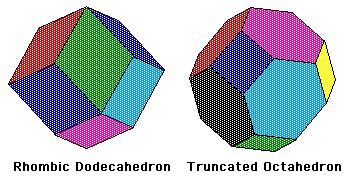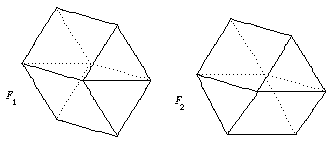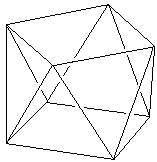
What are the duals of the rhombic dodecahedron and of the truncated octahedron ?
If we regard the stella octangula as the union of two tetrahedra T ∪ J(T) and colour T white and J(T) black, what are the symmetry groups then ?
Describe how you would colour the stella octangula to get a figure F with Sd(F) = D4 and S(F) = D4 × < J > .
 A figure F consists of a triangular prism with three square faces and two equiangular triangular faces.
A figure F consists of a triangular prism with three square faces and two equiangular triangular faces.
Describe the direct symmetry group of F and the full symmetry group of F.
 Two copies of F are put together in two different ways to make figures F1 and F2 as shown on the right.
Two copies of F are put together in two different ways to make figures F1 and F2 as shown on the right.
Describe the direct and full symmetry groups of F1 and F2.
 Show that the group of rotations of a regular prism Pn = P × I ⊆ R3 with P a regular polygon and I the unit interval, is the dihedral group Dn.
Show that the group of rotations of a regular prism Pn = P × I ⊆ R3 with P a regular polygon and I the unit interval, is the dihedral group Dn. What is its full symmetry group ?
A square antiprism (with two parallel square faces and eight isosceles triangles for the others) is as shown on the right:
Find its direct and full symmetry groups.
